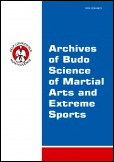2013, Volume 9, Issue 1
The correlation of bone density parameters with the body composition of students of the Police Academy – the perspective of preventing permanent damage to the body during physical training and interventions
Helena Stokłosa1, Władysław Mynarski2
1Department of Anatomy, The Jerzy Kukuczka Academy of Physical Education, Katowice, Poland
2Department of Recreation, The Jerzy Kukuczka Academy of Physical Education, Katowice, Poland
Full text
Abstract
Background and Study Aim: Above-average physical fitness required of candidates for police officers is determined by the level of somatic components belonging mainly to the musculoskeletal system. Aim of this study was to correlation between the parameters of bone density and body composition of students of the Police Academy.
Material and Methods: The study involved 29 candidates for the police officers who were selected from a group of 91 individuals, after the initial selection that included the assessment of fitness and physical performance. The average age of subjects was 24.24± 2.21 years. Body height and body mass was measured, and bioelectrical impedance method was used to evaluate body fat (FAT%, FAT mass), fat-free mass (FFM) and body mass index (BMI kg/m2). Ultrasonography (Achilles, Lunar Corp.) was used to estimate the density of the calcaneus. Following variables were analyzed: BUA, SOS, SI, T-score and Z-score.
Results: The mean Stiffness index was high as in 20 subjects it was more than 100% (109-137%). Two students were diagnosed with osteopenia (T-score = –1.42, –1.56). BMI was within the normal range in 56% of the subjects, and the fat content was normal in 76% of the students. The relationship between somatic and ultrasound parameters of bones, assessed by the Pearson correlation coefficient, showed a statistically significant association of SOS and Stiffness index with body mass, BMI, body fat and fat free mass.
Conclusions: Candidates for the policemen were characterized by normal bone tissue structure, and the cases of osteopenia indicated the need for non-invasive assessment of bone density in preliminary medical examinations for early identification of persons with a risk factor for osteoporosis.
Key words: osteoporosis, osteopenia, calcaneus ultrasonography, health-related training





